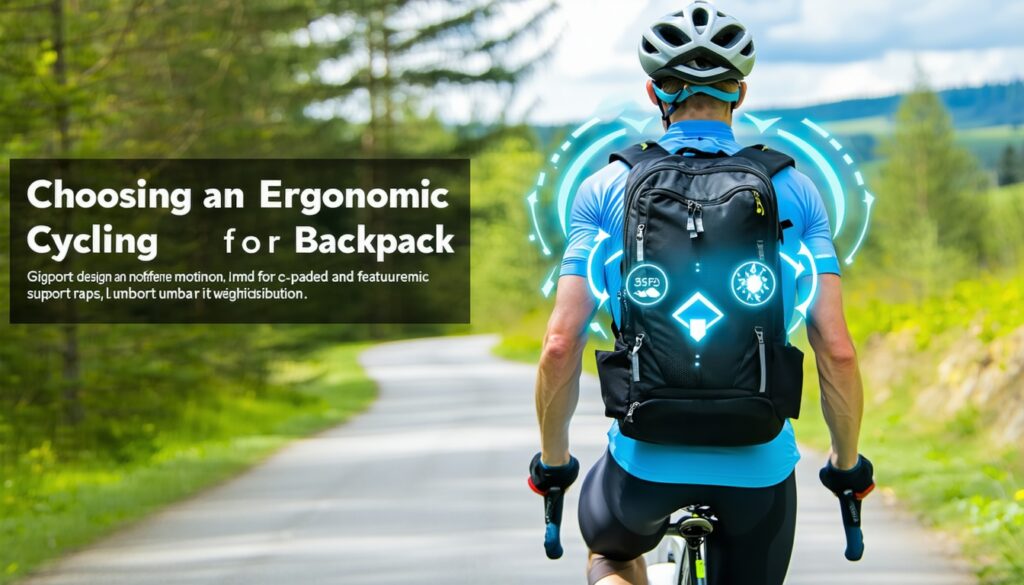How to Choose an Ergonomic Cycling Backpack for Comfort and Posture

Choosing an Ergonomic Cycling Backpack
Selecting the right ergonomic cycling backpack involves considering several comfort features and safety considerations to ensure a pleasant cycling experience.
Comfort Features to Look For
When it comes to comfort, several essential features should be prioritized in a cycling backpack.
-
Padded Shoulder Straps: Look for backpacks with plush shoulder straps that help distribute weight evenly, which reduces strain on the shoulders and back. Many ergonomic designs include additional support features like a chest strap for better weight distribution.
-
Adjustable Straps: Adjustable straps are vital for a proper fit. They allow cyclists to customize the pack’s position to align with their body, enhancing comfort during rides.
-
Ventilation Features: Backpacks that incorporate breathable materials and back ventilation systems help prevent excessive sweating. This feature is especially beneficial for long rides or warm weather.
-
Torso Length Adjustability: Choosing a backpack with adjustable torso length can further customize the fit, ensuring a comfortable carrying position while cycling.
Here is a summary table highlighting key comfort features:
| Comfort Feature | Description |
|---|---|
| Padded Shoulder Straps | Helps distribute weight, reducing shoulder strain |
| Adjustable Straps | Ensures a custom fit for different body types |
| Ventilation Features | Prevent excessive back sweat during rides |
| Torso Length Adjustability | Allows for a tailored fit for cycling comfort |
Safety Considerations
Safety is paramount when cycling, and certain features of a backpack can enhance rider safety.
-
Reflective Elements: Look for backpacks with reflective strips or materials. These additions improve visibility in low-light situations, making it safer for cyclists commuting during dawn or dusk.
-
Hydration Compatibility: Many cyclists prefer backpacks that accommodate hydration systems. Ensuring easy access to water during rides is essential for maintaining hydration and stamina (hydration-compatible cycling backpacks: what to look for).
-
Weather Resistance: Opt for a waterproof or water-resistant backpack to keep belongings dry during various weather conditions. Always verify the specifications to understand which parts of the suitcase are waterproof (waterproof vs water-resistant: choosing bike-safe backpacks).
-
Load Distribution Features: Look for backpacks designed with features like sternum and waist straps, which improve stability and help keep the backpack securely in place while riding.
By considering these comfort features and safety considerations, cyclists can make informed decisions on how to choose an ergonomic cycling backpack for comfort and posture.
Essential Backpack Features
Choosing the right features for a cycling backpack can significantly enhance comfort and efficiency while riding. Two essential aspects to consider are the closure type and waterproofing capabilities.
Roll-Top vs. Velcro Closures
The type of closure on a cycling backpack can impact durability and functionality. Roll-top closures are highly recommended for their robust design. These closures use a folding mechanism that creates a secure seal, making them less susceptible to wear and tear compared to Velcro or plastic buckles. They tend to last longer and provide a reliable barrier against the elements.
| Closure Type | Durability | Security | Ease of Access |
|---|---|---|---|
| Roll-Top | High | Excellent | Moderate |
| Velcro | Moderate | Good | Easy |
For those seeking durability and functionality, roll-top backpacks are an ideal choice. However, if ease of access is a priority, Velcro may be more suitable. For insights on urban cycling, consider reading should you use a roll‑top backpack for urban cycling?.
Waterproofing for Commuting
Weather conditions can drastically affect the cycling experience, making waterproofing a crucial feature. Most cycling backpacks are made to be waterproof; however, some only waterproof the main compartment. To ensure complete protection from rain or splashes, it’s beneficial to opt for a drybag-style cycling backpack, which offers enhanced water resistance.
A waterproof cycling backpack helps keep personal items dry and secure during commutes, contributing to overall comfort. When considering a backpack, take into account its ability to withstand various weather conditions, as highlighted in waterproof vs water-resistant: choosing bike‑safe backpacks.
| Waterproofing Level | Description |
|---|---|
| Fully Waterproof | All compartments sealed; ideal for heavy rain |
| Water-Resistant | Main compartment waterproofed; suitable for light rain |
| Not Waterproof | Basic protection may not withstand any moisture |
In summary, ensuring that your cycling backpack has a reliable closure system and proper waterproofing can enhance both your riding comfort and the safety of your belongings.
Prioritizing Comfort and Fit
Choosing an ergonomic cycling backpack involves ensuring comfort and fit to enhance the riding experience. Key aspects to consider are padded straps and ventilation, as well as adjustability and torso length.
Padded Straps and Ventilation
Padded shoulder straps are essential in any cycling backpack. They help evenly distribute weight across the shoulders, reducing strain and discomfort, especially during long rides. Additionally, many backpacks feature padded chest straps, which can further enhance stability. To find out more about how these straps can improve stability, check our guide on how sternum and waist straps improve stability on the bike.
Ventilation is another crucial comfort feature. A backpack with a well-designed back ventilation system allows airflow between the backpack and the rider’s back, preventing overheating and excessive sweating. This is particularly important on warm days. Exploring materials with breathable capabilities can help in this area. For more detailed information, read our article on why a ventilated back panel matters in a cycling backpack.
| Feature | Importance |
|---|---|
| Padded Straps | Reduce shoulder strain |
| Chest Straps | Improve stability |
| Ventilation | Prevent overheating and back sweat |
Adjustability and Torso Length
An ergonomic cycling backpack should include adjustable straps and torso lengths to ensure a proper fit. Different cyclists have unique body shapes and sizes, so being able to customize the fit ensures that the backpack sits securely and comfortably while riding. This can prevent any jostling or shifting during movement, allowing for a smoother ride.
By fitting a backpack properly, cyclists can maintain better posture while riding, which positively affects performance and reduces the risk of long-term discomfort. For more insights on finding the right size, consider checking out our tips for choosing the right backpack size for daily commutes here.
| Feature | Importance |
|---|---|
| Adjustable Straps | Customized fit for comfort |
| Torso Length Adjustment | Ensures proper fit for various body sizes |
Prioritizing these comfort and fit features will enhance a cyclist’s experience, allowing them to focus on the ride rather than discomfort.
Practical Tips for Cycling Backpacks
When riding a bike, selecting the right cycling backpack is essential for both comfort and posture. Here are some practical tips on how to ensure your backpack works with you rather than against you.
Packing Light for Comfort
Packing light is crucial to avoid strain on the back and shoulders while cycling. Heavier loads can negatively impact comfort and posture, particularly during long rides. Aim to pack only what you absolutely need. General recommendations suggest that carrying a load should not exceed 7.5% of your body weight. Exceeding this limit can lead to chronic issues like reduced mobility and degenerative conditions.
Here’s a simple table to help visualize how much weight to carry based on body weight:
| Body Weight (lbs) | Max Load (lbs) |
|---|---|
| 120 | 9 |
| 140 | 10.5 |
| 160 | 12 |
| 180 | 13.5 |
| 200 | 15 |
Distributing gear evenly in the backpack also aids in maintaining proper posture. Packing unevenly can impose awkward positions that result in muscle imbalances and strain on the body. For efficient packing tips, consider our guide on how to pack tools, snacks, and gear in a bike backpack.
Breathable Materials for Ventilation
To ensure a comfortable ride, cyclists should look for backpacks made from breathable materials. This will help prevent sweating and discomfort during rides. Backpacks equipped with ventilation systems allow for air circulation, which keeps the back cool and dry.
Consider backpacks that incorporate mesh panels or moisture-wicking materials for optimal comfort. These design choices significantly improve airflow and prevent overheating. For more on ensuring your backpack maintains airflow, check our article on why a ventilated back panel matters in a cycling backpack.
By prioritizing lightweight packing and choosing breathable materials, cyclists can enhance their comfort and overall riding experience.
Design Elements for Ideal Backpacks
Choosing the right design features in a cycling backpack is essential for enhancing comfort, functionality, and overall cycling experience. Two important aspects to consider are the capacity and storage compartments, as well as the durability of materials used in construction.
Capacity and Storage Compartments
The best cycling backpack generally offers an adequate capacity to accommodate daily essentials, typically ranging from 20 to 30 liters for regular use or 30 to 40 liters for longer excursions. Here’s a quick overview of suitable capacities based on use:
| Backpack Use | Recommended Capacity (liters) |
|---|---|
| Daily Commuting | 20 – 30 |
| Weekend Trips | 30 – 40 |
| Long-Distance Touring | 40+ |
The backpack should feature multiple storage compartments to keep items organized, including specific pockets for water bottles, tools, and other essentials. This organization not only maximizes space but also ensures that important items are easily accessible while riding. Features like hydration holders and compartments for tech gear contribute to a cyclist’s convenience on the go.
Durable Materials for Longevity
Durability is key when selecting a cycling backpack, as it needs to withstand various weather conditions and the rigors of cycling. Ideal materials include nylon and polyester, known for their lightweight yet robust characteristics. These materials offer water resistance, making them suitable for unpredictable weather conditions on rides.
Key attributes of these materials include:
| Material | Characteristics |
|---|---|
| Nylon | Lightweight, durable, and water-resistant |
| Polyester | UV-resistant and dries quickly |
The combination of these durable materials with ergonomic designs, such as padded backs and adjustable straps, enhances comfort and performance during rides. By ensuring the right features in terms of capacity and durability, cyclists can enjoy their rides while keeping their gear secure and protected. Additional considerations like reflective features that improve cycling visibility also play a significant role in creating an effective cycling backpack.
Focus on Cycling Backpack Ergonomics
Finding an ergonomic cycling backpack is essential for ensuring that cyclists maintain comfort and proper posture during rides. This section will provide insights on maximizing weight distribution and ensuring proper posture and core strength for an enjoyable cycling experience.
Weight Distribution Tips
Proper weight distribution is vital in reducing strain on the back and shoulders while cycling. An ergonomically designed backpack should feature padded shoulder straps and a chest strap to help evenly distribute the weight of the load. This setup minimizes pressure on specific areas, ensuring a more comfortable ride.
To effectively manage weight distribution, consider the following tips:
| Weight Distribution Tip | Description |
|---|---|
| Pack Closest to Your Back | Keep heavier items against your back for better balance. |
| Use Compartmentalization | Organize items in different compartments to prevent shifting during rides. |
| Secure Loose Items | Ensure that all items are secured to avoid movement that could disrupt balance. |
| Utilize Chest and Waist Straps | These straps can help stabilize the pack and lessen shoulder strain. how sternum and waist straps improve stability on the bike |
Proper Posture and Core Strength
Maintaining proper posture while cycling is crucial for reducing the risk of injury and ensuring a comfortable riding experience. The best cycling backpacks support this by allowing the rider to sit upright without straining the back. Proper alignment of the spine keeps the core engaged, which is essential for effective cycling.
Cyclists should focus on strengthening their core to support their posture. Here are some core-strengthening exercises beneficial for cyclists:
| Core Strengthening Exercise | Description |
|---|---|
| Planks | Helps build endurance in the core, which aids stability while cycling. |
| Russian Twists | Improves oblique strength, contributing to better torso stability. |
| Bridges | Strengthens the lower back and glutes, forming a stable base for cycling. |
| Leg Raises | Engages the lower abs, supporting an upright posture. |
Properly fitted ergonomic cycling backpacks also play a role in promoting good posture. The ideal cycling backpack should be lightweight, well-ventilated, and equipped with features to maintain comfort during rides. Riders can explore options such as hydration-compatible cycling backpacks: what to look for and those designed with breathable materials for ventilation to ensure an optimal cycling experience.
By focusing on weight distribution and core strength, cyclists can enhance their riding comfort and posture, making every journey enjoyable.
Importance of Load Balance
Understanding the concept of load balance is vital for any cyclist when selecting a backpack. Proper weight distribution not only enhances comfort but also significantly impacts overall posture and physical health during rides.
Impact on Spine Health
Carrying a backpack that is too heavy can adversely affect spine health. Research shows that backpacks heavier than 10% of an individual’s body weight have been linked to reduced spine length. Additionally, loads exceeding 7.5% can increase the risk of musculoskeletal injuries. This risk underscores the importance of selecting a cycling backpack that maintains proper load distribution relative to one’s body weight.
| Load Percentage | Risk Level |
|---|---|
| Up to 7.5% | Lower risk of injury |
| 7.5% – 10% | Increased risk of musculoskeletal injuries |
| Over 10% | Linked to reduced spine length |
Muscle Strain Prevention
Improper load distribution can lead to muscle imbalances, imposing asymmetrical strain on various body parts, including the neck, shoulders, and lower back. Packing items unevenly in the backpack exacerbates this issue, forcing the body into awkward positions. Uneven weight can cause chronic problems such as reduced mobility and degenerative conditions.
Loading a backpack with balance allows for an efficient and natural carrying experience, which can improve overall cycling posture. Choosing an ergonomic cycling backpack should include consideration for features that support weight management and load distribution.
For tips on how to properly pack your cycling backpack for optimal comfort, check our guide on how to pack tools, snacks, and gear in a bike backpack.
Backpack Design Recommendations
Choosing the right design for a cycling backpack can significantly enhance the comfort and performance of any cyclist. This section will compare various backpack types and outline optimal load carriage guidelines for ergonomic cycling.
Backpack Types Comparison
Different backpack designs cater to various cycling needs. Below is a comparison of common types of cycling backpacks, considering their features and suitability for different cyclists.
| Backpack Type | Key Features | Best For |
|---|---|---|
| Standard Backpack | General storage with adjustable straps | Daily commuting |
| Hydration Backpack | Includes a water reservoir and drinking tube | Long rides or trails |
| Roll-Top Backpack | Adjustable volume with a weatherproof seal | Commuters facing changing conditions |
| Laptop-Specific Backpack | Padded compartments for electronic gear | Urban cyclists need tech protection |
| Lightweight Backpack | Compact and minimal design for short trips | Quick rides or daily necessities |
Optimal Load Carriage Guidelines
Proper load carriage is essential for maintaining balance and reducing strain during rides. Here are some key guidelines to ensure optimal load distribution:
-
Weight Distribution: It is advisable not to exceed 40% of body mass when carrying a load, as excess weight can significantly affect posture and balance.
-
Use of Hip Belts: Incorporating a hip belt can help distribute weight more evenly across the body, alleviating pressure on the shoulders. This is particularly crucial for heavy loads.
-
Strap Design: Shorter and stiffer shoulder straps provide better load placement and stability, which is essential for energy efficiency during cycling.
-
High Load Placement: Positioning the load higher on the back can minimize energy expenditure and enhance balance while riding.
-
Ventilation and Weight: Lightweight designs reduce the strain on the cyclist’s body. A ventilated back panel can help manage sweat and heat.
-
Test the Fit: It’s important for cyclists to try on backpacks while simulating riding positions to ensure a proper fit and load distribution.
By taking these factors into account, cyclists can select a backpack that not only meets their storage needs but also supports their comfort and posture during rides.


